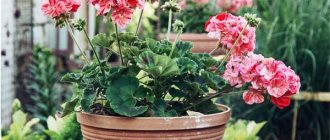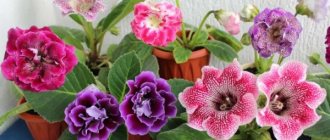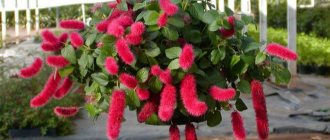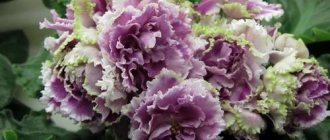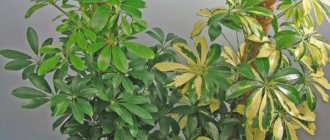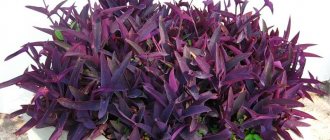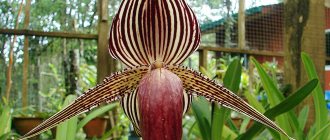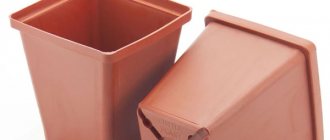A talented person is talented in everything. This statement also applies to the Russian programmer Konstantin Morev, who in his free time is engaged in breeding new varieties of violets. One of his creations is a large, large, incredibly romantic violet “Olesya”. It was bred relatively recently, the variety is not even 10 years old.
Dear readers! For you, we have created communities on social networks in which useful articles and interesting ideas are published several times a day! Subscribe and receive useful content in a convenient format!
Description of the variety
A beautiful, dense rosette, flowers of an amazing violet-pink hue, framed at the edges by a discordant, interrupted border of dark cherry color.
Pink petals smoothly flow into cream in the center of the flower. They themselves are small, there are many of them in one rosette, they bloom long and profusely.
The flowers surprise with their luxury, and at the same time they are very delicate and cute, exuding a faint aroma. They do not change their color, and the next year the flowering becomes even more luxurious and lush.
Leaves
The leaves are soft green, quilted, slightly fluffy and delicate.
They are medium in size, sink to the ground and do not cover the flowers.
During its full flowering, the rosette grows and almost completely covers the leaves, so that they can be difficult to see.
Flowers
Outwardly, it is very similar to the Dushechka variety. It differs in some nuances and shades of color - Darling has more pastel and calm tones, “Olesya” is much brighter and more cheerful.
Characteristics of species with photos
Tired Sun
Variety 2005. The rosette is large, with long petioles, and quite neat. The leaf is dark green, quilted. The flowers are large (up to 6 cm), from simple, in the first flowering, to heavily double.
The color of violet petals is salmon pink, with a darker spot in the center . The spot appears on the seventh day after the bud opens and gradually begins to grow. Depending on the conditions of detention, the central spot can completely fill the petals, but usually its spread ends 4-5 millimeters from the edge of the petal, creating the effect of a wide border.
Attention : The variety feels great without additional lighting. When propagating, children from the leaf produce quickly, actively grow and gain green mass. It blooms seven months after planting.
Stone Flower
Variety 2007. Standard socket. The leaves are large and wavy (some breeders write about severe leaf curling that occurs with excess light). The foliage is rich green.
The flowers are medium (up to 4 cm), semi-double and double. The color of the petals is ruby-violet, with darker tips, a white border and a greenish fringe. The violet bud blooms lighter, more monochromatic and darkens throughout the entire flowering period , the corner areas of the petals much faster.
By the end of flowering, some parts of the flower are almost black. The color of the fringe also becomes more saturated towards the end of flowering and stands out strongly against the background of the petals. The structure of the petals is dense, which allows them to better tolerate changes in air humidity. The bud opens completely in 3 weeks.
It produces flower stalks not at once, but gradually, so it is unlikely to get an abundant head of flowers.
When propagated by leaves, the violet produces babies reluctantly . It grows and develops very slowly to the size of a large starter. Then it begins to gain leaf mass more actively. An adult plant is unpretentious. It feels great on a windowsill with natural light and tolerates overflow and drought well.
apple blossom
It is not recognized as a variety by the breeder himself, but it has made an impression on many flower growers and is included in their collections.
The rosette is not very neat, but can be trained when the light changes. The petioles of the leaves are a little long. The foliage is lush green, edged with white.
The flowers are simple and semi-double, located on slender peduncles that cope well with a large number of buds. The color of the petals is soft pink. The flowering of Saintpaulia is very abundant and frequent, it blooms with a cap .
Does not like excessive lighting. Feels good on eastern window sills. When growing on a shelf, it is better to place it on the edge of the shelf.
Olesya
Seedling. The socket is neat and compact. The foliage is medium green and quilted. The flowers are quite large (up to 5 cm), very lush and elegant. The shape resembles a hemisphere. The color of the petals is unusual - bright neon pink with a darker eye and cherry speckled edges.
The plant produces a large number of flower stalks, each with 4-5 buds . Therefore, it blooms with an amazingly beautiful and lush head. Flowering is long lasting, can last more than 2 months. Sometimes you have to remove the flower stalks so that the rosette has time to gain green mass.
“Olesya”, when propagated by leaves, quickly produces babies. After transplantation, it grows and develops well, gaining green mass. An adult rosette is unpretentious and easily tolerates changes in light, temperature and humidity.
We recommend watching a video about K. Morev’s violet variety “Olesya”:
Summer night
Variety 2007. The rosette is large and loose. The leaves are lush green, slightly wavy.
The flowers are large (up to 6 cm), semi-double and double. The color of the petals is violet-blue with a white center and a white border around the edge. As it develops, “blurry effects” appear in the center of the petals. In bright light, the color of the petals fades slightly to a warm lilac .
Flowering is long, up to 2 months, but the plant produces flower stalks irregularly. The variety is sensitive to temperature changes. If the room was cool when the buds were planted, the flowers will be lighter, and sometimes almost white, with light blue prints.
“Summer Night”, when propagated by leaves, quickly produces babies . After transplantation, it grows and develops quickly. Sports happen, but not often. The variety does not tolerate flooding and excess light very well; in this case, the leaves become light green or turn yellow. In principle, it will feel good on the windowsill, without additional lighting.
Photo of violet "Olesya" Morev
“Violet” art by K. Morev
One of the breeders whose varieties of violets have become real favorites among flower growers is Konstantin Morev from Moscow. Even as a child, he became interested in plant breeding. And this was facilitated by his acquaintance with the luminary of “violet” art, Boris Mikhailovich Makuni, who lived in the same building as the boy’s family.
According to experienced Saintpaulists, Konstantin Morev’s flowers are in no way inferior to the best foreign varieties . As the breeder himself says in one of his interviews, for him selection is constant selection and improvement, and this process is endless.
Despite the fact that Konstantin’s main profession is not related to biology, he is a programmer by training, and “from his pen” came such popular varieties among flower growers as Frosty Cherry, Blue Fog, Greenhouse Effect, Pink Panther, Wedding Bouquet and many others . His new varieties are awaited; people specially come to exhibitions for them. Let's get acquainted with the description of the famous varieties of violets of this talented breeder.
Growing conditions
Violets, in principle, are grateful flowers, ready to grow in any soil. But in order for the variety to fully reveal all its qualities, the necessary conditions must be created for the flower.
Find out a detailed description of other varieties of violets: “Blue Fog”, “Cinderella’s Dream”, “Blue Dragon”, “Lituanica”, “Ice Rose”, “Esmeralda”, “Summer Twilight”, “Chanson”, “Jan Minuet”, etc. .
Correct placement
Violets are light-loving plants, but at the same time they are contraindicated in a lot of sun.
They will feel best on the east side of the apartment.
They will also bloom well on a southern windowsill - you just need to shade them well in the summer heat.
Lighting
This violet will definitely need additional lighting in short winter days, otherwise it will not form new buds and will not bloom.
Temperature
She is thermophilic, the optimal temperature for her is 22-24 degrees. For young plants - 24-26 degrees.
Humidity
For adult plants, normal room humidity is sufficient. They can be sprayed with a spray bottle 2-3 times a week. Young children are kept in greenhouses under plastic wrap.
Pot
The size of the pot primarily depends on the size of the violet itself - it must be selected in accordance with the root system of the flower itself. If you have just purchased a “baby” flower, it is very tiny, then you need the smallest pot for it.
At first, even a disposable plastic one will do. As it grows, the pots will need to be changed and replanted according to size.
For an adult flower, you need a ceramic pot, not covered with any decorations on the outside.
Its maximum height and width is 10 cm, otherwise the leaf mass will grow, but it will not bloom - the root system will grow, the plant will spend all its energy on strengthening the root, and there will be no energy left for flowering itself. In addition, in a constantly humid and warm environment, bacteria, fungi, and mold will actively begin to multiply.
If you are germinating a violet from a leaf, the leaf should be placed in a small plastic 100-gram cup in water, wait until the roots appear and transplant into exactly the same cup with soil, and wait until it takes root.
Priming
You can buy ready-made soil or make your own.
After all, if you purchased low-quality soil, this will certainly lead to the death of the flower in the very near future. What is poor quality soil? This is one that contains:
- pathological microorganisms that cause mold
- various foreign debris - twigs, leaves, etc.
- plaque of unknown origin
- acidic soil
A good, high-quality soil for violets is multi-component. It includes:
- peat - it should be fluffy, not clogged, and crumble well in your hands. This is the main component, about 2/3 of the volume is taken
- activated carbon - 2-3 crushed tablets. They will prevent soil acidification
- soil baking powder
- sorbents that absorb moisture - they will retain water, but at the same time prevent the earth from becoming waterlogged.
Properly prepared soil for flowers has a light, airy, uniform structure that is pleasant to the touch.
Important! Baking powders and sorbents often have a very strong odor that can burn your respiratory tract. Try not to inhale it too deeply, so as not to harm your health.
Caring for a plant at home
At home, caring for Saintpaulia is not difficult , the main thing is:
- Follow the rules of agricultural technology;
- And choose the right location.
By providing a standard care package , the violet will show long and lasting flowering.
Conditions of detention
For active growth and lush flowering at home, the SM-Olesya violet needs to be provided with certain maintenance conditions, consisting of :
- Proper watering;
- Feeding;
- Lighting;
- Humidity;
- Soil qualities.
Proper watering and fertilizing
Frequent, excessive watering will lead to rotting of the root system . The frequency of watering depends on:
- Indoor microclimate;
- At low temperatures;
- And good humidity.
The violet must be watered carefully.
Watering is carried out when the top layer of soil dries . For irrigation, use settled water at room temperature.
Saintpaulia will respond well to nutritious watering with fertilizer . A young plant will quickly gain a thick green mass of leaves, and an adult plant will abundantly form strong flower stalks.
Advice! If the violet has stopped blooming and looks drooping, you need to add nitrogen-containing fertilizer to the water for irrigation. The situation will change instantly. Such feeding is especially important in the spring, when after winter the plant is weakened due to short daylight hours and needs additional nutrition.
Lighting and air temperature
For growing Uzambara violet Olesya, the best choice would be eastern windows , but in the summer you need to shade the plant from aggressive sunlight, providing shading.
The Moreva seedling develops well in rooms with temperatures from +20 to + 24. In hot weather, the SM-Olesya violet feels good, but you should avoid excessively high temperatures in the room.
Effect of air humidity
The air humidity in the room should fluctuate between 50-60% . And for growing small Saintpaulias, greenhouses are created for them, where the microclimate is warmer and the humidity is much higher.
Advice! To increase humidity, use humidifiers, or spray from a spray bottle next to the violets, avoiding water particles getting on the leaf plate of the plant.
What kind of soil does he prefer?
A correctly selected earthen substrate is the key to good growth and the formation of healthy, strong flower stalks, which will allow the plant to bloom magnificently and for a long time.
Soil for violets can be bought at a flower shop.
For Saintpaulia you need light soil, with the addition of baking powder, which will provide:
- Good air circulation;
- And it will not allow excess water to stagnate.
It is better to buy a ready-made substrate for Saintpaulia; it should be neutral in acidity. You can also use top soil to prepare the substrate, adding to it :
- Perlite;
- Vermiculite;
- Foam balls;
- And sphagnum moss.
Tip: When making your own substrate for violets, it is better to use a large plastic container with a lid to mix and store the earthen mixture. The soil in such a container does not dry out.
Pruning and hygiene
The formation of the correct rosette begins with the size of the child . It is regularly necessary to remove unnecessary stepsons that form in the axils of the leaves. They:
- The socket is deformed;
- And they take on additional nutrition from the mother plant.
Faded flower stalks are also removed. Diseased or deformed leaves are also removed , and old foliage that forms the fifth row of leaves is also removed; it does not help in the development of the violet, but only wastes the plant’s nutrients.
Reproduction methods
This variety reproduces :
- Seeds;
- Dividing the bush;
- Stepchildren;
- And cuttings.
An adult rosette produces many small daughter rosettes .
Flower growers identify the two most convenient methods of propagation :
- Growing a plant from a cutting;
- Growing a young rosette from a stepson.
the leaves of an adult violet for cuttings from the second row of the rosette , and from the best peduncle that blooms strictly with the varietal characteristics of the variety.
Most often, Saintpaulias are propagated by leaves.
The cut cuttings are planted in shallow containers with a small amount of soil, the substrate is slightly moistened and placed in a greenhouse. You can also root the cuttings in water by adding an activated carbon tablet to it.
Important! Grown-up violet children are removed from the mother leaf when they have formed two pairs of leaves.
Rules for transplantation and rejuvenation
Regular transplantation of adult violets is a guarantee :
- Healthy plant;
- And the future of the lush flowering variety.
Important! The variety is replanted after every second flowering, by transferring the coma or by completely replacing the soil with fresh and more nutritious one.
An adult violet is rejuvenated when the plant reaches the age of two to three years . The violet has an ugly stem that:
- Cut back to new young leaves;
- And they re-root in a fresh substrate under a greenhouse until the plant sprouts new young roots.
Planting and propagation
When planting, it is important not to damage the root system of the plant.
The flower must be held above the pot so that the roots fit freely in the pot and do not touch its walls and bottom.
Gradually fill the flower with the prepared soil and moisten the soil well.
A violet of the same variety can be grown from a leaf of the plant; it just needs to be kept in water until the roots appear.
You can also propagate by cuttings - sprout roots.
Transplant rules, rejuvenation
Uzambara violet is replanted once a year, usually after every second flowering. Young plants are transplanted using the transshipment method, preserving the earthen lump as much as possible.
Important! The diameter of the pot when transplanting should be three times smaller than the diameter of the rosette. In a pot that is too large, the roots of the plant do not have time to absorb all the soil, and the soil begins to sour.
Adult violet rosettes are rejuvenated when the bare stem of the flower reaches about 5 cm:
- Cut off the upper trunk, with two or three tiers of leaves;
- Peel the stem like a carrot;
- And they are placed in new soil for rooting.
Advice! To quickly develop a new root system, the rejuvenated rosette is placed in a greenhouse.
The remaining stump of the old rosette with leaves can not be thrown away, but left and continued care. Stepchildren will soon form on it.
Care
This variety is unpretentious in care.
Watering
Daily watering is not required. Water under the root to keep the soil slightly moist.
Top dressing
Fertilizers are of two types, mineral and organic. They are applied two to three times a month during watering.
Transfer
Transplanting is a more effective way to feed plants by replacing the soil in which they grow. Remove the exhausted one and plant it in a freshly prepared one. This can be done once every 2-3 months.
Keeping seedlings in indoor culture
Flower growers with great pleasure purchase seedlings of K. Morev for their collections, since these violets, which do not have varietal status, possess most of the characteristic qualities of the variety. Both seedlings are different:
- Unpretentious character;
- Easily adapt to room microclimate;
- They produce early and vigorous flowering.
To achieve this, violets need only careful and careful implementation of the most common agrotechnical measures and procedures:
- It is correct to place violets - on a western or eastern window; specimens on northern windows require additional lamps with a diffuse spectrum; on southern windows, artificial shade is required;
- Water in small volumes when the effect of slight drying of the upper volume of the substrate appears;
- Apply additional mineral fertilizers, focusing on the decorative appearance of violets;
- Lighting is created for the most part natural, long-lasting and diffused spectrum;
- Control the appropriate temperature level - within +20 + 24°C, excluding sudden fluctuations in indicators;
- Plant using nutritious, permeable soil with good aeration and a thick layer of drainage;
- When transplanting, use transshipment more often, except in special cases;
- Correct humidity indicators using any possible methods, avoiding only spraying the violets themselves.
Diseases and pests
Flowers, alas, also get sick. And they also have enemies.
Diseases
These include various damage to the flower itself, stems, and leaves.
These are various rots, late blight, bacteriosis and others. Damage to the roots of the flower is no less dangerous.
A coating forms on the flower, from which it dies. You can cope with the problem with the help of special herbal remedies.
Pests
These are insects that eat the flowers or leaves themselves - aphids, mites, butterfly larvae and the like. Special chemicals that need to be sprayed on violets will help deal with them.
Varieties of violets: what are they?
To systematize the varietal diversity of violets, experts have developed a classification based on the size of the rosette, color characteristics, structure and size of the flower, shape and color of the leaves. Based on the size of the rosette of leaves, there are 4 main groups:
- miniature - rosette diameter from 6 to 12 cm;
- semi-mini - rosette diameter from 15 to 20 cm;
- standard - rosette diameter from 20 to 40 cm, the most numerous group;
- large, or giants - diameter up to 60 cm.
According to flower size, varieties are divided into: small-flowered (2–4 cm in diameter), large-flowered (4–6 cm in diameter) and especially large. Based on the structure of the flower, they are classified into simple, semi-double and double. Depending on the complexity of the colors, they are divided into single-color, two-tone, two-color and multi-color.
Based on the characteristics of the shape and color of the flower, the following are distinguished:
- classic
- star-shaped
- bordered
- fantasy
- chimeras
There is a more detailed classification of flower shapes, where in addition to the classic and star-shaped, they distinguish “bell”, “bowl”, “pansy” and “wasp”.
The leaves of different varieties of Saintpaulia also differ. There are varieties with a classic green color, and there are variegated ones. According to the shape and structural features, the leaves can be: round, oval, heart-shaped, elongated; with a curled, ragged, jagged or wavy edge.
